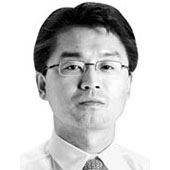Real estate revolution

The author is a senior editorial writer of the JoongAng Ilbo.
In his celebrated manifesto “Towards a New Architecture,” French architect Le Corbusier (1887-1965) famously wrote, “A house is a machine for living in.” I recall a Le Corbusier exhibition in Seoul in March 2017. His radical theory defying the decorative traditions for homes came about in the early 1920s, when the working class was devoid of decent living spaces in the wake of World War I.
It was a time of revolutionary movements. Le Corbusier raised the choice of “architecture or revolution?” and suggested a revolution can be avoided if the “machines” for living are distributed en masse. After World War II, he acted on what he preached. He built multi-residential unit Unite d’Habitation, a 12-story building with equal spaces for 337 households. The housing design soon became a model in Europe for the first modern apartment, according to the exhibition.
Seoul is an exemplary case of Le Corbusier’s housing concepts. People across the country flocked to Seoul at the height of the Miracle on the Han in the 1960s and 70s. Young people rushed to the capital with dreams of becoming rich and successful. A sudden spike in population worsened the housing crisis. Some even floated the idea of requiring permits to move to Seoul.
It was President Park Chung Hee who promoted multi-residential apartments. The Mapo Apartment Complex created in 1964 with 10 units of six-story buildings became the first housing concept borrowed from Le Corbusier. Park touted the Mapo apartments as “the symbol of the Korean revolution.” Such “living machines” have since proliferated in Korea. Half of 20 million households in Korea live in apartments as of 2018. The country is truly a republic of apartments.
President Moon Jae-in is still battling soaring apartment prices after vowing to prevail over the real estate market no matter what. After idling away more than three years, the government and ruling party are suddenly on a campaign to bring an end to the days when apartments can build wealth. They promise to force owners of multiple homes to sell houses through tax bombardments. They assure the working and middle class that they will be able to buy homes at affordable prices eventually. However, are housing prices the same as volatile commodities like fresh food, for which the prices come down eventually after spikes from droughts or floods are over?
Korea’s apartment prices came down sharply only twice in history: in the wake of the 1997 Asian financial crisis and 2008 global financial meltdown. There has been talk about the crumbling of the “Gangnam myth” or a Japan-like bursting of asset bubbles. Those who believed that hoopla must be hitting themselves.
People must not be deceived by the grandiose concept of “housing justice.” Presidential Chief of Staff Noh Young-min had to dispose of his two apartments after he was found to have saved one expensive apartment in southern Seoul. Kim Jo-won, a former senior presidential secretary for civil affairs, chose to keep two multi-million-dollar apartments in Gangnam and sacrifice his job. The fact that about 40 percent of senior government officials own homes in the posh neighborhoods of Gangnam suggests the “Seoul apartment myth” lives on. We criticize them, but also envy them.
“Where do you live?” is one of the first questions people ask an acquaintance. The answer tells a lot about the person’s social, education and economic status. The theory that homes would be left empty when the population thins and housing supply rate exceeds 100 percent is a lie. Gone are the days when people will settle for a place to sleep. The innate aspiration and demand to live in Seoul — especially in the posh districts of Gangnam — won’t die. If the government is sincere about achieving justice in housing, it should endeavor to provide good neighborhoods like Gangnam in major cities across the country. The ruling party head called Seoul a “vulgar city,” but who knows if its apartment architecture could one day win Unesco heritage recognition like Unite d’Habitation?
Korea once faced a social revolution due to a housing crisis. In 1989, under the general-turned politician President Roh Tae-woo, housing prices soared 56 percent. Anti-government rallies were still feverish following the Gwangju Democratization Movement. Roh’s economic secretary Moon Hee-gap warned that a revolution could take place. The Roh government built 2 million housing units by creating suburban cities on the outskirts of Seoul.
Public sentiment today is also at a boiling point. With or without homes, people have become anxious and unhappy. Apartments have become out of reach to common people. Tenants must live in insecurity as they are forced to convert to monthly rents from jeonse, or long-term housing deposits. The middle class fear losing their homes because they cannot afford to pay mounting taxes.
Real estate is a ticking bomb. The reckless real estate policy could inflame public furies and disgruntlement from other woes, such as the protracted coronavirus crisis and other contradictions of the ruling front. “Architecture or revolution?” — the choice posed by Le Corbusier applies to today’s Korea.










with the Korea JoongAng Daily
To write comments, please log in to one of the accounts.
Standards Board Policy (0/250자)